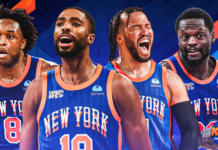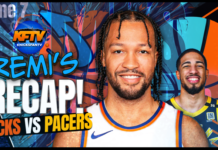The Knicks split back-to-back games with the Kings and Bulls. They dug holes against both teams but competed hard to earn the split.
The New York Knicks split a doubleheader, defeating the Sacramento Kings 120-109 before losing to the Chicago Bulls 108-100. The Knicks trailed by large margins to start both games but only had enough energy to make a comeback in the first.
Both games were marked by slow starts and overachieving role players for the opposition. The Knicks let Keon Ellis go off to open the Kings game, leading to a 21-point deficit they had to fight back from. But New York locked in, chipping away at the lead in the second quarter, tying the game after three quarters, and dominating the fourth.
Chicago started similarly, with Ayo Dosunmu and Javonte Green doing the damage. But this time, New York ran out of steam before completing the comeback. They were down by 20 points in the first quarter, got the lead down to five by the third, but never got over the hump. Fatigued from the back-to-back and missing Josh Hart after a flagrant 2 foul, the Knicks didn’t have the energy to close.
Let’s look at the individual performances that made up this back-to-back split.
The Knicks’ starters get OG back, but still start slow
Jalen Brunson:
Game One: 35 PTS (12/20 FG, 2/5 3PT, 9/10 FT), 11 AST, 2 REB, 3 STL, 3 TO in 38 mins
Game Two: 35 PTS (13/28 FG, 1/5 3PT, 8/10 FT), 11 AST, 6 REB, 2 STL, 5 TO in 42 mins
Jalen Brunson proved himself a star with magnificent performances in both games. The Kings sent double-teams all the way out to the logo just to get the ball out of Brunson’s hands. The Bulls weren’t as aggressive but still consistently sent multiple defenders. Brunson often fed the ball to a teammate at the top of the key, then worked through screens to come back to get it. But if Brunson got anything resembling one-on-one coverage, he scored on defenders.
Brunson’s playmaking is clear from the eleven assists in each game. But it looked even better than the numbers suggest. He picked apart teams, sending no-look passes to cutters and kickouts to shooters. He drew a huge amount of attention and chewed up the defense as a result.
But it wasn’t a perfect pair of performances. The added attention led to more turnovers than we’re used to, and Brunson was guarding Ellis in Sacramento and Dosunmu to start in Chicago. The defensive woes and turnovers dip him to a 4.5 out of 5, despite two incredible performances.
Donte DiVincenzo:
Game One: 21 PTD (6/13 FG, 5/9 3PT, 4/5 FT), 1 AST, 5 REB, 1 BLK, 1 TO in 39 mins
Game Two: 10 PTS (4/12 FG, 2/7 3PT), 3 AST, 4 REB, 1 BLK, 2 TO in 33 mins
Donte DiVincenzo played a huge role in New York’s comeback against the Kings. He started the game shooting poorly but heated up in the second quarter and exploded in the third. He often managed to take swing passes and drive to the rim for some acrobatic finishes. In addition to scoring, his defense looked great, with a trailing block on Ellis and a number of deflections.
But DiVo didn’t have the same legs for Chicago. His shot never warmed up, and he gave up blow-by drives on multiple defensive sets. His game had flashes of everything he did well in Sacramento but lacked consistent efficacy.
The Knicks needed more from DiVo in Chicago, but understandably, he ran out of steam after a great effort in Sacramento. The Big Ragu gets a 3 out of 5 for the games combined.
Josh Hart:
Game One: 31 PTS (14/19 FG, 3/4 FT), 8 AST, 9 REB, 2 STL, 4 TO in 43 mins
Game Two: 0 PTS (0/2 FG), 1 AST, 1 REB in 11 mins
Josh Hart played one of his best games as a Knick in Sacramento. He played with a sprained wrist, which meant shooting was never an option. But that also meant he flew into action whenever he caught a weak side pass. Hart acted without hesitation, attacking the rim with reckless abandon and finishing his array turn-around jumpers and layups.
Hart became a one-man transition attack in Sacramento, grabbing boards and getting New York easy buckets and momentum. His rebounding and energy were sorely missed for most of the Chicago game. Hart tried to drive and got stripped in mid-air, the contact spun him around and he managed to kick Javonte Green in the head. That landed him an ejection.
It’s unfortunate that Hart’s great effort in Sacramento was followed by a dubious ejection in Chicago. I doubt Green goes off so easily if Hart is around to match his energy with physicality. Hart gets a 2.5 for one perfect game and one disappointing conclusion.
OG Anunoby:
Game One: DNP
Game Two: 12 PTS (5/8 FG, 2/4 3PT), 1 REB, 2 STL, 2 TO in 29 mins
OG Anunoby returned for the Bulls game only. He looked rusty early, missing a few open looks. But by the second half, Anunoby settled in and looked like himself again. He hit his threes, finished inside, and made a fast move inside for a dunk.
Anunoby’s defensive impact didn’t hit its final form, but there were flashes. He and Hartenstein switched back and forth in a few defensive sequences that kept the Bulls’ jumbo lineups from getting anything easy. Those lineups sometimes included Nikola Vucevic and Andre Drummond simultaneously, which shows how impactful OG’s length can be.
Anunoby gets a 2.5 out of 5 for his return game, as he’s only just starting.
Isaiah Hartenstein:
Game One: 7 PTS (3/4 FG, 1/2 FT), 9 AST, 7 REB, 2 STL in 29 mins
Game Two: 10 PTS (3/5 FG, 4/6 FT), 2 AST, 7 REB, 3 STL, 1 BLK, 4 TO in 30 mins
Isaiah Hartenstein’s minutes are starting to tick up, and his performances were strong. I-Hart’s passing stole the show in Sacramento. Hartenstein cooked the Kings from the top of the key, flying up to help when the teams doubled Brunson and sending some beautiful lead passes. He threw passes that would make Nikola Jokic proud, from no-looks to 20-foot bounce passes to players in motion.
Hartenstein didn’t have as much space to create in Chicago but battled well against the giant-bodies in Chicago. He struggled to keep Andre Drummond off the boards like everyone else, but he made Drummond miss from inside on multiple occasions. The Chicago game was hampered by turnovers, with I-Hart forcing some passes in traffic.
I-Hart gets a 3 out of 5 for one great performance and one that was mid.
New York’s second unit finally gets Bogey going
Miles McBride:
Game One: 12 PTS (4/13 FG, 3/10 3PT, 1/2 FT), 3 AST, 4 REB, 1 TO in 43 mins
Game Two: 19 PTS (6/11 FG, 4/7 3PT, 3/3 FT), 2 AST, 7 REB, 1 TO in 38 mins
Deuce McBride started Sacramento ice cold. He had to force shots late in the shot clock, which threw his rhythm off, and he missed open looks after. But he got hot in the third quarter and gave the Knicks a boost. His defense never faltered, either, with him forcing De’Aaron Fox to make tough shots and threes for his offense.
McBride looked even better in Chicago. He knocked down his jumpers consistently and scored more efficiently. Deuce flashed finishing touch on several trips to the paint, including a left-handed finish for an and-one in the third that looked beautiful. His game keeps expanding.
McBride gets a 3.5 out of 5 for elite defense with an additional scoring punch. He looks like a future sixth man of the year candidate.
Alec Burks:
Game One: 0 PTS (0/1 FG), 2 STL in 9 mins
Game Two: 0 PTS (0/2 FG, 0/1 3PT), 2 REB, 1 TO in 8 mins
Alec Burks didn’t get much time to impact either game. But I’ll give him credit for some good and timely hedging in Sacramento that helped lead to some steals. He didn’t get much off in Chicago, but there wasn’t much time to work. Burks didn’t force shots or offense in either game, and that’s a nice first step toward getting on track.
Bojan Bogdanovic:
Game One: 12 PTS (5/7 FG, 2/3 3PT), 1 REB, 1 TO in 12 mins
Game Two: 9 PTS (3/9 FG, 1/4 3PT, 2/2 FT), 1 AST, 1 REB, 2 TO in 20 mins
Bojan Bogdanovic is finally looking like himself, at least in spells. Bogey got to his spots and scored consistently against Sacramento. He received the ball in motion for most of his action, which got him downhill momentum. His best moves came from driving hard and bumping defenders off balance to create space on pull-up jumpers.
Bogey continued to attack downhill in Chicago but showed signs of fatigue. He didn’t have the same success shooting from a distance and sometimes looked a step slow. There was one particular moment in transition defense when Bogdanovic had plenty of time to help close the lane but watched Green drive and dunk instead.
Bogdanovic looked his best in Sacramento but lost a step in Chicago. He gets a 2.5 out of 5, but he’s finally finding his place in the offense.
Precious Achiuwa:
Game One: 0 PTS (0/2 FG, 0/1 3PT), 3 REB, 1 TO in 9 mins
Game Two: 0 PTS (0/2 FG, 0/1 3PT), 1 AST, 4 REB, 1 STL, 1 TO in 19 mins
Precious Achiuwa looked out of sorts in the matchup with Sacramento. He seems less comfortable dealing with true centers than against power forwards and hybrid bigs. Sabonis is too big and tactful for Precious’ hard work to make up the gap in size.
Achiuwa had similar issues with Andre Drummond, and who could blame him? Drummond is much bigger, and Precious still made a commendable effort against the stronger opponent. Precious dove for a loose ball in the third quarter, showing that he was willing to fight despite his struggles.
I won’t kill Achiuwa for struggling with bigger guys. But this wasn’t his best set of games. Achiuwa gets a 1.5 out of 5.
Mitchell Robinson:
Game One: 2 PTS (0/1 FG, 2/6 FT), 2 AST, 7 REB, 1 BLK in 15 mins
Game Two: 5 PTS (2/4 FG, 1/3 FT), 1 AST, 5 REB, 1 STL in 11 mins
Mitchell Robinson is still getting his feet under him. He looked a bit slow and lumbering in both games compared to his pre-injury form. But he imposed his size on the action in both games. He grabbed rebounds at an impressive rate, and the slashers looked scared to challenge him.
Mitch especially impressed me with his matching up against Andre Drummond. Drummond looked overpowering even against Hartenstein at times. But Robinson wouldn’t budge and often left Drummond flailing in hopes of fouls.
Mitch only played 26 minutes combined; he’s getting his legs under him. But there are promising signs from the back-to-back, worth a 2.5 out of 5. His free throws are still bad, though.
Tom Thibodeau has to get the team started faster
I don’t know that we can blame Tom Thibodeau for it, but the Knicks have turned starting slow into a habit. They trailed by 20 points or more in the first quarter of both games, and double-digit deficits have become commonplace before they get going.
The thing is, the Knicks got plenty of good looks but bricked the shots. They gave up shots to the players they’d typically want shooting the ball, but those guys made their shots. So maybe it’s bad luck, but Thibodeau needs to go to the tape and see how he can turn the trend around.
Closing Thoughts
Before Sacramento tipped off, we got the news that Julius Randle will have season-ending surgery. It’s a gut punch because we’ve been looking forward to his return, and the Knicks never let on how bad the shoulder injury was. It’s bittersweet, but how nice is it that Randle’s gone from someone who faced boos from his home crowd a couple of years ago to a player the fanbase panics over losing for a few months.
I wish Randle the best, and New York’s “next man up” mentality is necessary now. But OG and Mitch are back, so reinforcements have arrived with just enough time to get their legs back. The Knicks can still make noise in the playoffs if those two players round into form. They simply have to stop spotting the opposition 20 points to start games.
The Bucks are next, and they’re reeling. They’ve lost three in a row, and New York is only two games back from them in the standings. Let’s see if the Knicks can get the win and make the last few games an exciting race for playoff position.
Let us know your thoughts in the comment section below! Stay tuned to KnicksFanTV.com for the latest Knicks news, rumors, and recaps throughout the NBA season. Subscribe to the newsletter for KFTV content and events, shop discounts, and more at bit.ly/kftvmail. And in case you missed it, check out Alex Trataros and Dalton Sell’s preview of the matchup between the Knicks and Bucks!










